Because of choosing redstone forest as my penology cite I got a unique opportunity to observe a natural space that is right in the middle of a busy campus. I would argue that this cite was a perfect example of how nature and culture are intertwined as redstone pines is a natural space that was created by and designed for people to spend time in. Every person on campus that I have talked to has been in or at least knows where redstone pines is and most of them have stories to tell about the area. I personally met one of my best friends in UVM at redstone pines. I’m not sure that I feel like I am a part of my penology cite as it was designed by someone rather than being a natural forest but I do feel a connection to the area because of the experiences I have had there with my friends.
17 Apr
Redstone phenology blog post 4/16
Returning to my phenology spot in redstone forest the most major difference I saw from the last time I visited was the wetness of the ground. The grass was soaked and there were plenty of muddy wet spots scattered throughout. I couldn’t find any signs of amphibians around but I could definitely imagine salamanders living in that area if there were more fallen trees to provide shelter. All of the trees in redstone forest are pines and as such they maintain their foliage year round. There were some smaller bushes however that appeared to be starting to bud. The edge effect is very relevant for redstone forest as the whole “forest” is less than an acre and is surrounded by human development on all sides. The only species that I have observed in redstone forest are rabbits and squirrels as there is very little edible foliage for larger animals like deer.

20 Mar
Spring break at home phenology cite update
My at home phenology cite is an area of woods located behind my house in Brookline MA called Lost Pond nature reserve. Originally the area that lost pond was built on was an area of forest that contained the town dump. It was used at a storage place for the towns trash for many years but after the dump was capped the town needed a new use for the land. It was decided that the land would be converted to protected forest and that trails would be made to run through it so that people could enjoy the woods. Given that it had snowed early in the week I couldn’t observe anything on the ground layer but there were plenty of other trees and tall shrub sticking out of the snow. One of the major differences I noticed between this forest and my phenology spot in Vermont is that there were allot less coniferous trees in Brookline than there were in Burlington. I also noticed that there were allot more animal tracks and a greater variety of animal tracks in my at home penology spot than my one in Vermont. While I didn’t see any birds during my time in the woods I did find an empty birds nest in a bush while walking back.
https://www.google.com/search?q=lost+pond+nature+reserve+brookline&npsic=0&rflfq=1&rlha=0&rllag=42329222,-71143569,3186&tbm=lcl&ved=0ahUKEwj3tLrBo_vZAhUDu1MKHTRjCtQQtgMIKw&tbs=lrf:!2m1!1e2!3sIAE,lf:1,lf_ui:1&rldoc=1#rlfi=hd:;si:15924782820980019758;mv:!1m3!1d19049.90727595041!2d-71.14356995!3d42.32838295!2m3!1f0!2f0!3f0!3m2!1i412!2i310!4f13.1
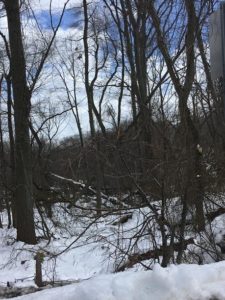
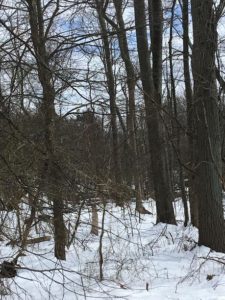
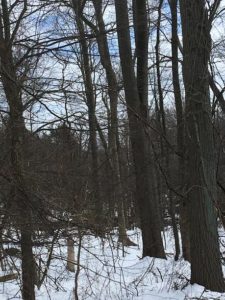
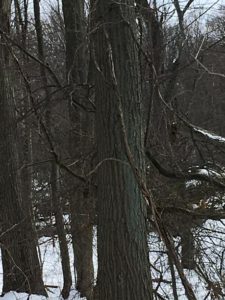
3 Feb
New year, new phenology

The first set of tracks that I found when revisiting my phenomenology cite were actually not from a wild animal at all but were from someones dog. The tracks seemed to snake around the trees with no clear destination.
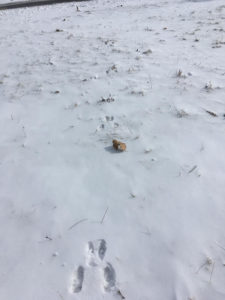
All of the rest of the tracks that I observed were from rabbits. When I went to check my phenology cite it had snowed the night before so any tracks would have been made overnight. I was very surprised by the shear number of bunny tracks that there were in the fresh snow, they all seemed to be concentrated within the boarders of the small pine stand with only one set of tracks clearly leaving the Redstone Pines in the direction of the main campus. If I had to guess why there were so many rabbit tracks around I would assume that it was because the Redstone Pines are surrounded by people and buildings on every side. This would provide protection from land dwelling predictors like foxes because those animals like to avoid interaction with humans.
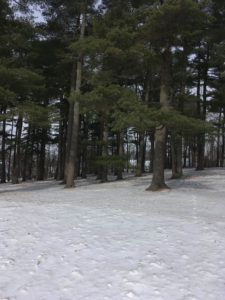

There were not many changes to the trees from the last time I visited due to the fact they are all evergreen. The small shrubs close to the ground were the only ones that lost their leaves and died back. Redstone Pines, as the name would suggest, is entirely pine trees and as such there were no twigs of deciduous trees to observe. I did however sketch the end of a branch on one of the pine trees. All of the needles seemed to be green with very few brown and dead needles leading me to believe that the trees were all quite healthy.
10 Dec
Redstone past human use
Visiting Redstone Forest for the last time as a blog location I realized how little it changed from the time I first went there till now. Since the “forest” mostly consists of evergreen trees, there was not much change in foliage. There was not much change either on plants at ground level as most of the ground is grass. There was however a change in the animals that showed up there, it was allot more quiet the last time I was there. I couldn’t hear or see any birds. The same goes for squirrels and chipmunks.
It was hard to come up with many details about the human history of Redstone other than that over the years there was controversy about weather it was UVM land or Burlington land. The use of the land however has stayed pretty much the same as a recreational natural space open to the public.
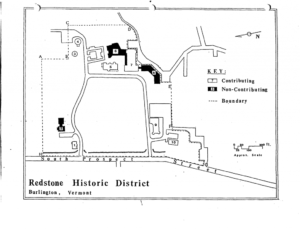
28 Nov
Lost Pond Sanctuary
For my thanksgiving blog post I decided to go to some woods that I was very familiar with, Lost Pond nature sanctuary. The entrance to Lost Pond sanctuary is located right at the end of my street and consists of thirty acres of walking trail and a large publics works building that houses many of the town’s municipal vehicles like trash trucks and utility vehicles. As the name implies there is also a pond back in the woods called Lost Pond. It is quite small, but is a home to many animals including frogs, salamanders, turtles and ducks. In the rest of the woods there are many other animals like squirrels, deer and coyote. There is a quite large coyote population, even from my house I can hear them howl at night.
Lost Pond sanctuary is very different from Redstone Woods in many ways. For starters, Redstone Woods is under an acre while Lost Pond sanctuary is thirty acres. Lost Pond sanctuary is also far more natural and less disturbed by people than Redstone Woods is. In Lost Pond the area that is commonly disturbed by people is quite small and only consisted of the trails that run through there. Lost Pond sanctuary in general has a very low foot traffic and is mostly only used by people who live in my neighborhood. Redstone on the other hand is used by most of UVM’s campus. Along with that there is far less plants on the ground level than at Lost Pond and more grass that is commonly stepped on by people.


24 Nov
Redstone forest event map
There are very few ecological events that affect Redstone woods given its man made and managed by the university. Because of this the biggest impact on the land is the people who use it for recreation so I decided to show that by drawing some contributions to those impact. These include a paved walking path, a hammock attached to two trees and a Frisbee.
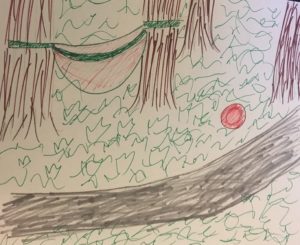
Poem:
Redstone forest fam
A nice place to chill sometimes
I’d relax there soon
24 Nov
Bird’s eye Redstone map
As the temperate has changed between the times I have visited this location there has been less foliage on some of the smaller ground level plants but for the most part the appearance has not changed much. The major difference that I observed was in the amount of people around. There were many less hammocks than before and the whole area seemed quieter. As for wildlife the only animals I observed were squires and one seagull.
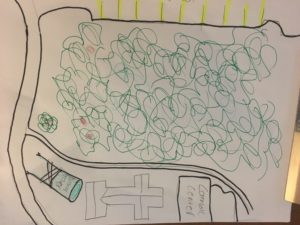
24 Nov
Introduction to Redstone
Red stone woods is a small area of woods mostly containing Easter White Pine with at least one Red Oak near the edge. It is a common recreational area within UMV campus that is both utilized by students and the rest of Burlington population. People can often be seen there hammocking (either doing homework or taking a nap), tossing a Frisbee or walking their dogs. The ground is mostly covered in grass but has some areas of low ground dwelling plant population, mostly ferns and small shrubs.
(insert picture here)
24 Nov
Link to Phenology
https://www.google.com/maps/place/University+of+Vermont/@44.4708267,-73.1987342,19.47z/data=!4m5!3m4!1s0x4cca7a5bbde60cf1:0x2df5d83e5a01e9b2!8m2!3d44.4778528!4d-73.1964637
Recent Comments